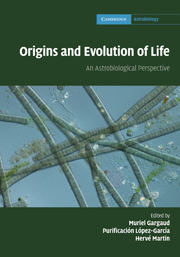Book contents
- Frontmatter
- Contents
- List of contributors
- Foreword
- Preface
- Part I What is life?
- Part II Astronomical and geophysical context of the emergence of life
- Part III The role of water in the emergence of life
- Part IV From non-living systems to life
- Part V Mechanisms for life evolution
- Part VI Life in extreme conditions
- 22 Life in extreme conditions: Deinococcus radiodurans, an organism able to survive prolonged desiccation and high doses of ionizing radiation
- 23 Molecular effects of UV and ionizing radiations on DNA
- 24 Molecular adaptations to life at high salt: lessons from Haloarcula marismortui
- Part VII Traces of life and biosignatures
- Part VIII Life elsewhere?
- Index
22 - Life in extreme conditions: Deinococcus radiodurans, an organism able to survive prolonged desiccation and high doses of ionizing radiation
from Part VI - Life in extreme conditions
Published online by Cambridge University Press: 04 February 2011
- Frontmatter
- Contents
- List of contributors
- Foreword
- Preface
- Part I What is life?
- Part II Astronomical and geophysical context of the emergence of life
- Part III The role of water in the emergence of life
- Part IV From non-living systems to life
- Part V Mechanisms for life evolution
- Part VI Life in extreme conditions
- 22 Life in extreme conditions: Deinococcus radiodurans, an organism able to survive prolonged desiccation and high doses of ionizing radiation
- 23 Molecular effects of UV and ionizing radiations on DNA
- 24 Molecular adaptations to life at high salt: lessons from Haloarcula marismortui
- Part VII Traces of life and biosignatures
- Part VIII Life elsewhere?
- Index
Summary
The high stress resistance of the bacterium Deinococcus radiodurans
Deinococcus radiodurans (D. radiodurans), initially isolated in canned meat that had been irradiated at 4000 grays in order to achieve sterility (Anderson et al., 1956), is a bacterium belonging to a bacterial genus characterized by an exceptional ability to withstand the lethal effects of DNA-damaging agents, including ionizing radiation, ultraviolet light and desiccation (Battista and Rainey, 2001).
Initially, D. radiodurans was named Micrococcus radiotolerans because of its morphological similarity to members of the genus Micrococcus. Subsequent studies led to its reclassification into a distinct phylum within the domain Bacteria and this bacterium was renamed Deinococcus radiodurans, the Greek adjective deinos meaning strange or unusual. Deinococcaceae were isolated from diverse environments after exposure to high doses of ionizing radiation. Among this family, containing to date more than 20 identified members, D. radiodurans is by far the best characterized. D. radiodurans cells are non-motile, non-spore-forming and are obligate aerobes that grow optimally at 30°C in rich medium. On agar plates, they are pigmented and appear pink-orange. In liquid media, cells divide alternately into two planes, exhibiting pairs or tetrads (Figure 22.1A).
Ionizing radiation, when applied to any living organism, leads to the formation of highly reactive radicals (e.g. hydroxy radicals) and can cause a variety of DNA damage, such as DNA single- and double-strand breaks and base modifications.
- Type
- Chapter
- Information
- Origins and Evolution of LifeAn Astrobiological Perspective, pp. 347 - 358Publisher: Cambridge University PressPrint publication year: 2011
- 2
- Cited by



